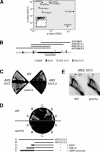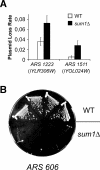Control of replication initiation and heterochromatin formation in Saccharomyces cerevisiae by a regulator of meiotic gene expression
- PMID: 16077008
- PMCID: PMC1182343
- DOI: 10.1101/gad.334805
Control of replication initiation and heterochromatin formation in Saccharomyces cerevisiae by a regulator of meiotic gene expression
Abstract
Heterochromatinization at the silent mating-type loci HMR and HML in Saccharomyces cerevisiae is achieved by targeting the Sir complex to these regions via a set of anchor proteins that bind to the silencers. Here, we have identified a novel heterochromatin-targeting factor for HML, the protein Sum1, a repressor of meiotic genes during vegetative growth. Sum1 bound both in vitro and in vivo to HML via a functional element within the HML-E silencer, and sum1Delta caused HML derepression. Significantly, Sum1 was also required for origin activity of HML-E, demonstrating a role of Sum1 in replication initiation. In a genome-wide search for Sum1-regulated origins, we identified a set of autonomous replicative sequences (ARS elements) that bound both the origin recognition complex and Sum1. Full initiation activity of these origins required Sum1, and their origin activity was decreased upon removal of the Sum1-binding site. Thus, Sum1 constitutes a novel global regulator of replication initiation in yeast.
Figures






Similar articles
-
Design of a minimal silencer for the silent mating-type locus HML of Saccharomyces cerevisiae.Nucleic Acids Res. 2010 Dec;38(22):7991-8000. doi: 10.1093/nar/gkq689. Epub 2010 Aug 10. Nucleic Acids Res. 2010. PMID: 20699276 Free PMC article.
-
Conversion of a gene-specific repressor to a regional silencer.Genes Dev. 2001 Apr 15;15(8):955-67. doi: 10.1101/gad.873601. Genes Dev. 2001. PMID: 11316790 Free PMC article.
-
Structural analyses of Sum1-1p-dependent transcriptionally silent chromatin in Saccharomyces cerevisiae.J Mol Biol. 2006 Mar 10;356(5):1082-92. doi: 10.1016/j.jmb.2005.11.089. Epub 2005 Dec 20. J Mol Biol. 2006. PMID: 16406069
-
Silencers, silencing, and heritable transcriptional states.Microbiol Rev. 1992 Dec;56(4):543-60. doi: 10.1128/mr.56.4.543-560.1992. Microbiol Rev. 1992. PMID: 1480108 Free PMC article. Review.
-
The dual role of autonomously replicating sequences as origins of replication and as silencers.Curr Genet. 2009 Aug;55(4):357-63. doi: 10.1007/s00294-009-0265-7. Epub 2009 Jul 26. Curr Genet. 2009. PMID: 19633981 Review.
Cited by
-
Differential requirement of DNA replication factors for subtelomeric ARS consensus sequence protosilencers in Saccharomyces cerevisiae.Genetics. 2006 Dec;174(4):1801-10. doi: 10.1534/genetics.106.063446. Epub 2006 Sep 15. Genetics. 2006. PMID: 16980387 Free PMC article.
-
Evolutionary and reverse engineering to increase Saccharomyces cerevisiae tolerance to acetic acid, acidic pH, and high temperature.Appl Microbiol Biotechnol. 2022 Jan;106(1):383-399. doi: 10.1007/s00253-021-11730-z. Epub 2021 Dec 16. Appl Microbiol Biotechnol. 2022. PMID: 34913993
-
Different nucleosomal architectures at early and late replicating origins in Saccharomyces cerevisiae.BMC Genomics. 2014 Sep 13;15(1):791. doi: 10.1186/1471-2164-15-791. BMC Genomics. 2014. PMID: 25218085 Free PMC article.
-
Analysis of chromosome III replicators reveals an unusual structure for the ARS318 silencer origin and a conserved WTW sequence within the origin recognition complex binding site.Mol Cell Biol. 2008 Aug;28(16):5071-81. doi: 10.1128/MCB.00206-08. Epub 2008 Jun 23. Mol Cell Biol. 2008. PMID: 18573888 Free PMC article.
-
A Link between ORC-origin binding mechanisms and origin activation time revealed in budding yeast.PLoS Genet. 2013;9(9):e1003798. doi: 10.1371/journal.pgen.1003798. Epub 2013 Sep 12. PLoS Genet. 2013. PMID: 24068963 Free PMC article.
References
-
- Beall E.L., Manak, J.R., Zhou, S., Bell, M., Lipsick, J.S., and Botchan, M.R. 2002. Role for a Drosophila Myb-containing protein complex in site-specific DNA replication. Nature 420: 833-837. - PubMed
-
- Bell S.P. and Dutta, A. 2002. DNA replication in eukaryotic cells. Annu. Rev. Biochem. 71: 333-374. - PubMed
-
- Bell S.P., Kobayashi, R., and Stillman, B. 1993. Yeast origin recognition complex functions in transcription silencing and DNA replication. Science 262: 1844-1849. - PubMed
Publication types
MeSH terms
Substances
LinkOut - more resources
Full Text Sources
Molecular Biology Databases
